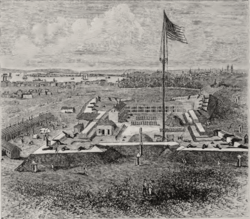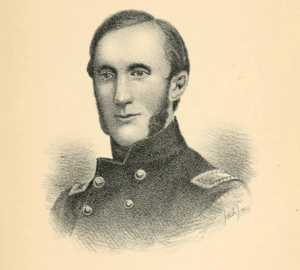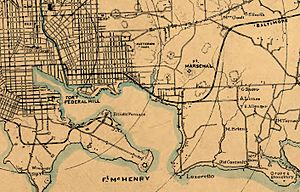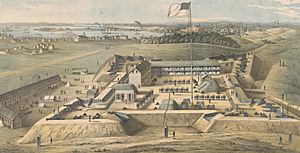Fort Marshall facts for kids
Quick facts for kids Fort Marshall |
|
|---|---|
| Baltimore, Maryland | |

Fort Marshall in 1863
|
|
| Type | Bastion fort |
| Site information | |
| Owner | United States Army |
| Site history | |
| Built | 1861 |
| Built by | 7th Maine Volunteer Infantry Regiment |
| In use | 1861-1866 |
| Materials | Earth & timber |
| Fate | Demolished 1866, Redeveloped as a Catholic Church 1873 |
| Events | Defense of Baltimore, part of the American Civil War |
| Garrison information | |
| Garrison | 400 capacity |
Fort Marshall was an important old fort located in Baltimore, Maryland. It was built in 1861, right at the start of the American Civil War. Its main job was to protect the eastern side of Baltimore from attacks by the Confederate army.
The fort was shaped like a star, which was a common design for forts back then. It stayed active throughout the war. After 1866, the fort was taken apart. Later, a church called Sacred Heart of Jesus Roman Catholic Church was built where the fort used to be. Today, the area is part of busy neighborhoods in southeast Baltimore.
Contents
Why Fort Marshall Was Built
When the Civil War began in 1861, the Union Army needed to make sure Baltimore was safe. Lieutenant Colonel Henry Brewerton was put in charge of making the city's defenses stronger. Old forts like Fort McHenry and Fort Carroll were not in good shape.
So, Brewerton fixed up the old forts and built many new ones. These included Fort Federal Hill and Fort Worthington. The army also set up many roadblocks and made homes ready for soldiers to defend the city. Baltimore became almost like a giant military base. The Union Army was determined to keep the city safe from Confederate forces.
Fort Marshall was a key part of this defense plan. It was built on a high spot called "Snake Hill," which was about a mile and a half from the city center. Being on higher ground meant its cannons could see a wider area than those at Fort McHenry.
The 7th Maine Volunteer Infantry Regiment mostly built Fort Marshall in the fall of 1861. It was named after Colonel Thomas H. Marshall, an officer from that regiment who had recently passed away in Baltimore. The camp outside the fort was called Camp Emory, named after Union General Emory Upton.
The fort had 33 large artillery guns, and by the end of the war, it had 60! It worked together with Fort McHenry, which was on the other side of Baltimore's harbor. Fort Marshall also had barracks that could house 400 soldiers. It even had an underground room for storing gunpowder, called a magazine.
Life at Fort Marshall
Fort Marshall was one of Baltimore's most important defenses during the war. Its strong dirt walls were close to the city center. It protected the eastern side of the city, along with Fort Worthington, from any Confederate attacks. The fort also guarded the Union military hospital nearby at Patterson Park.
Baltimore itself had some people who supported the Confederacy. So, the forts helped keep order inside the city while protecting it from outside attacks. Soldiers from Fort Marshall often patrolled the city. This helped remind people that the Union Army was in charge.
Celebrations like the Fourth of July at the forts included big cannon salutes. These were not just for the holiday but also to show that Fort Marshall was ready for anything. Soldiers from the fort also guarded train lines and bridges. They even went on raids to find hidden goods meant for the South. One time, they found gunpowder, knives, and rifles worth a lot of money hidden in Canton.
Daily Life for Soldiers
Being stationed at Fort Marshall was often used as a training camp for new Union soldiers. They would train there before being sent to active battlefields. Soldiers often said that life at Fort Marshall was "monotonous," meaning a bit boring. However, they had "more liberty" than at Fort McHenry.
The fort was known for being peaceful. The 5th New York Heavy Artillery Regiment even advertised for new recruits in 1862, saying there would be "no long toilsome marches" and "good warm and comfortable barracks."
Even though it was peaceful, the fort sometimes faced small night attacks from Confederate supporters. These attacks usually did not cause much harm. Diseases were a common problem in the barracks. Most injuries or deaths happened because of accidental weapon firings. For example, a Navy commander was once thrown 30 feet when he walked in front of a firing cannon during a salute.
Fort Marshall's End
The defenses at Fort Marshall were never seriously tested during the war. By late 1864, the fort was mostly used as a hospital. Visitors in May of that year noticed that its buildings were looking "dilapidated," or run down.
In November 1865, after the Civil War ended, Captain William Price Craighill took over from Lieutenant Colonel Brewerton. He started making repairs at Fort Marshall. However, plans changed quickly. In May 1866, the army announced that everything at the fort would be sold. This included almost 3,000 barrels of rifle powder, nearly 10,000 cannon powder cartridges, and many gun parts.
Just four days after the auction, the soldiers in charge of the fort's supplies were either moved or let go. By July, even the fort's buildings were being sold for firewood. Much of the wood was used by the Freedmen's Bureau to build more than sixty new schoolhouses. The fort was taken apart so completely that by 1869, people said its outline was just "a mark of the times gone by." Cows and goats now grazed where the fort's walls once stood.
After the government left the site, the area started to become a neighborhood. Around 1870, it became known as "Highland Town." In 1872-1873, a group of German Catholic priests bought the land where Fort Marshall had been. They leveled the hill and built the Sacred Heart of Jesus Roman Catholic Church there.
One last reminder of the fort was the Fort Marshall Brewing Company. It started in 1869 near the fort's old location. It operated until 1899 and helped make southeast Baltimore a center for German-American brewing. This trend continued into what is now the "Brewer's Hill" area.
Soldier Units at Fort Marshall
- 17th Connecticut Infantry Regiment (1862)
- 18th Connecticut Infantry Regiment (1862-1863)
- 2nd Delaware Infantry Regiment (1862)
- 21st Regiment, Indiana Volunteer Infantry (1861-1862)
- 11th Indiana Infantry Regiment (Wallace's Zouaves) (1865)
- 7th Maine Volunteer Infantry Regiment (1861)
- 5th Regiment Massachusetts Volunteer Militia (1864)
- 17th Regiment Massachusetts Volunteer Infantry (1862)
- 18th Regiment Massachusetts Volunteer Infantry (1863)
- 5th New York Heavy Artillery Regiment (1862)
- 5th New York Volunteer Infantry (Duryée's Zouaves) (1862)
- 8th New York Heavy Artillery Regiment (1863)
- 7th New York Militia (1863)
- 17th Regiment New York National Guard Infantry (1863)
- 18th Regiment New York National Guard Infantry (1863)
- 19th Regiment New York National Guard Infantry (1862)
- 150th New York Volunteer Infantry Regiment (1862-1863)
- 131st Ohio Infantry (1864)
- 137th Ohio Infantry (1864)




